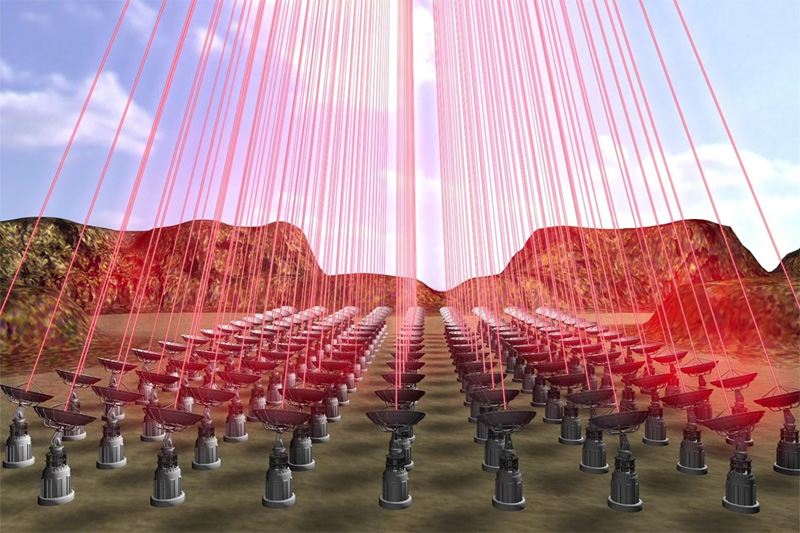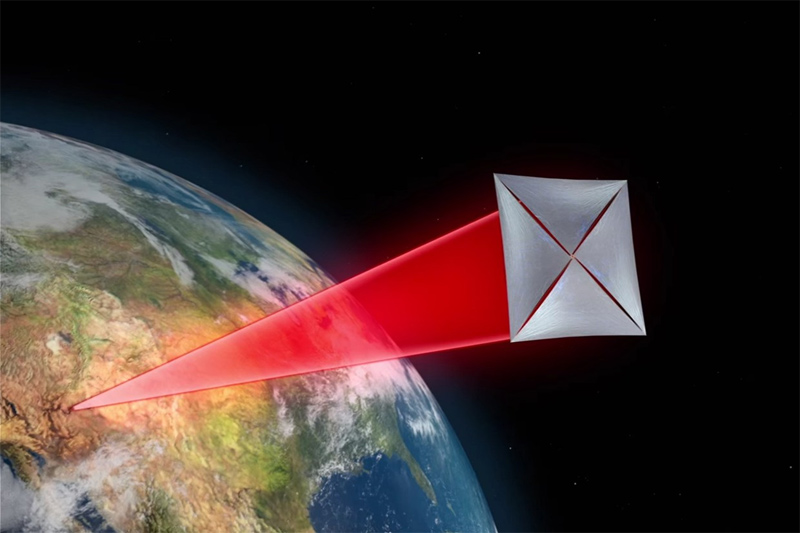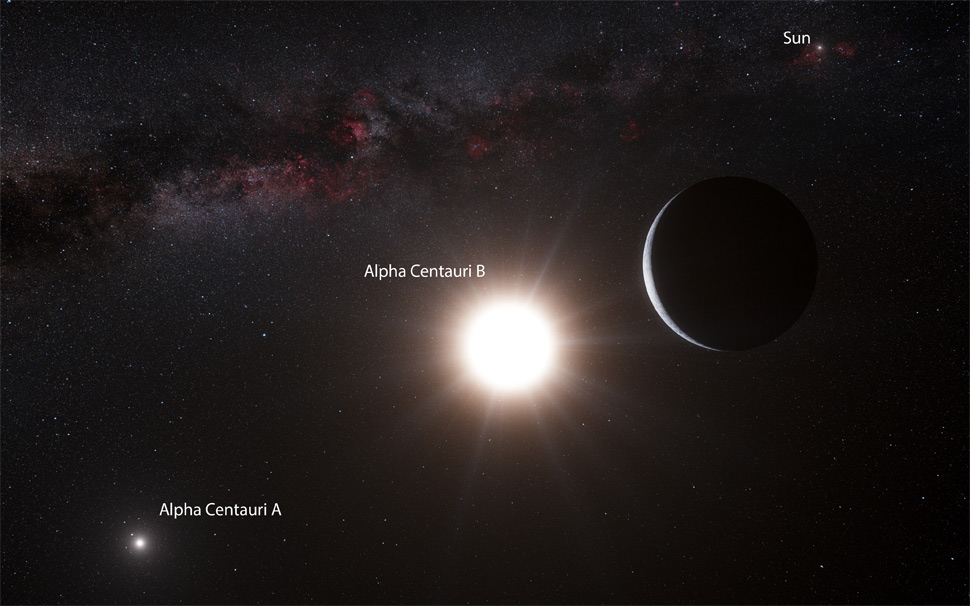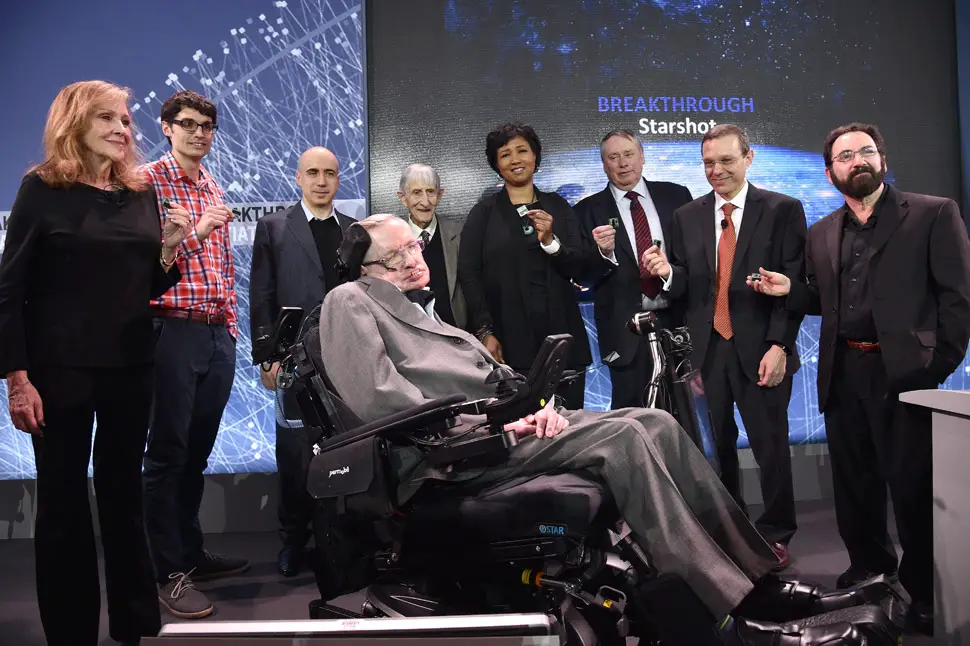
16th April 2016 High-speed probes could travel to Alpha Centauri within 20 years A group of scientists has announced "Breakthrough Starshot" – a program to develop a fleet of nanocraft probes able to reach the nearest star within 20 years and return images to Earth.
Science philanthropist Yuri Milner has announced a space research and engineering program called "Breakthrough Starshot". This aims to demonstrate a proof of concept for using light beams to push "nanocraft" probes to 20 percent of light speed. A possible fly-by mission could reach Alpha Centauri within 20 years of being launched, beaming back images and data four years after that. Pete Worden – the former director of NASA's AMES Research Center – will lead the program, with advice being provided from a committee of world-class scientists and engineers. The board will consist of Stephen Hawking, Yuri Milner, and Mark Zuckerberg. The Alpha Centauri star system is 25 trillion miles (4.37 light years) away. With today's fastest spacecraft, it would take about 30,000 years to get there. Breakthrough Starshot would aim to develop solar sails pushed by light beams, allowing tiny probes to fly over 1,000 times faster – taking advantage of exponential advances in certain areas of technology since the beginning of the 21st century.
"If we are to survive as a species, we must ultimately spread out to the stars," Professor Hawking said in a BBC interview. "Astronomers believe that there is a reasonable chance of an Earth-like planet orbiting one of the stars [in] the Alpha Centauri system. But we will know more in the next two decades from ground-based and space-based telescopes. Technological developments in the last two decades and the future make it possible in principle within a generation." If an Earth-size planet is lurking in the Alpha Centauri system, Breakthrough Starshot will try to aim its probes within 1 Astronomical Unit (150 million kilometres or 93 million miles) of it. From this distance, its cameras could potentially capture an image of high enough quality to resolve surface features. The spacecraft fleet would consist of 1,000 probes, and each craft, called a "StarChip", would be a very small, centimetre-sized device weighing only several grams. They would be propelled by arrays of ground-based lasers of up to 100 gigawatts. Each tiny spacecraft would transmit data back to Earth using a compact on-board laser communications system.
Each probe would comprise two main parts: StarChip: Moore's law has allowed a dramatic reduction in the size of microelectronic components. This creates the possibility of a gram-scale wafer, cameras, photon thrusters, power supply, navigation and communication equipment, constituting a fully functional space probe. Lightsail: Advances in nanotechnology are producing thinner and lighter metamaterials, promising to enable the fabrication of metre-scale sails no more than a few hundred atoms thick. These could be folded prior to launch, then unfurled once in orbit. The rising power and falling cost of lasers, consistent with Moore's law, will lead to significant advances in light beaming technology in the coming years. Breakthrough Starshot aims to leverage this trend, bringing economies of scale to the astronomical scale. A StarChip could be mass-produced at the cost of an iPhone and be sent on missions in large numbers to provide redundancy and coverage. The light beamer would be modular and scalable. Once it is assembled and the technology matures, the cost of each launch is expected to fall to a few hundred thousand dollars.
The research and engineering phase is expected to last about two decades. Following that, development of the ultimate mission to Alpha Centauri would require a budget comparable to the largest current scientific experiments, and would involve: • Building a ground-based, kilometre-scale light beamer at high altitude in dry conditions These and other system requirements represent significant engineering challenges. However, the key elements of the proposed system design are based on technology either already available or likely to be attainable in the near future under reasonable assumptions. As with previous major projects – such as the International Space Station (ISS) and Large Hadron Collider – global co-operation and support would be needed. As the technology required for interstellar travel matures, additional opportunities could emerge, including the following: • Contribution to Solar System exploration Astronomers believe there is a reasonable chance of an Earth-like planet existing in the habitable zones of Alpha Centauri's three-star system. A number of scientific instruments – both ground-based and space-based – are being developed and enhanced, which will soon identify and characterise planets around the nearest stars. A separate initiative will support some of these projects.
Breakthrough Starshot is a long-term project that could run until the 2050s or later. It aims to foster an open and collaborative environment that is: • Based entirely on research that is in the public domain During its announcement, Milner's team outlined the biggest challenges facing the mission. These include: developing a two megapixel camera able to be miniaturised to the sub-gram scale; a tiny plutonium-238 or Americanium-241 battery; a thin and strong lightsail able to survive extreme acceleration; and a laser array with sufficient focus to bypass atmospheric turbulence. It is hoped that a large swarm of 1,000 spacecraft will have "safety in numbers" and will compensate for any losses caused by interstellar dust collisions en route to their target. The team estimates that each square centimetre of frontal cross-section will impact at high speed with about a thousand particles of 0.1 microns or larger. New materials will be needed for the sails and other components to withstand these bombardments, in addition to coping with decades of cold vacuum. As well as these technical hurdles, Breakthrough Starshot will need substantial amounts of funding – between $5 and $10 billion. Milner himself has donated $100 million for the initial research. If successful, the first craft could launch about 20 years from now. "The human story is one of great leaps," said Milner in the press conference. "Today, we are preparing for the next great leap... to the stars." "We take inspiration from Vostok, Voyager, Apollo and the other great missions," said Pete Worden. "It's time to open the era of interstellar flight." "Earth is a wonderful place, but it might not last forever," said Professor Hawking. "Sooner or later, we must look to the stars. Breakthrough Starshot is a very exciting first step on that journey."
---
Comments »
|











